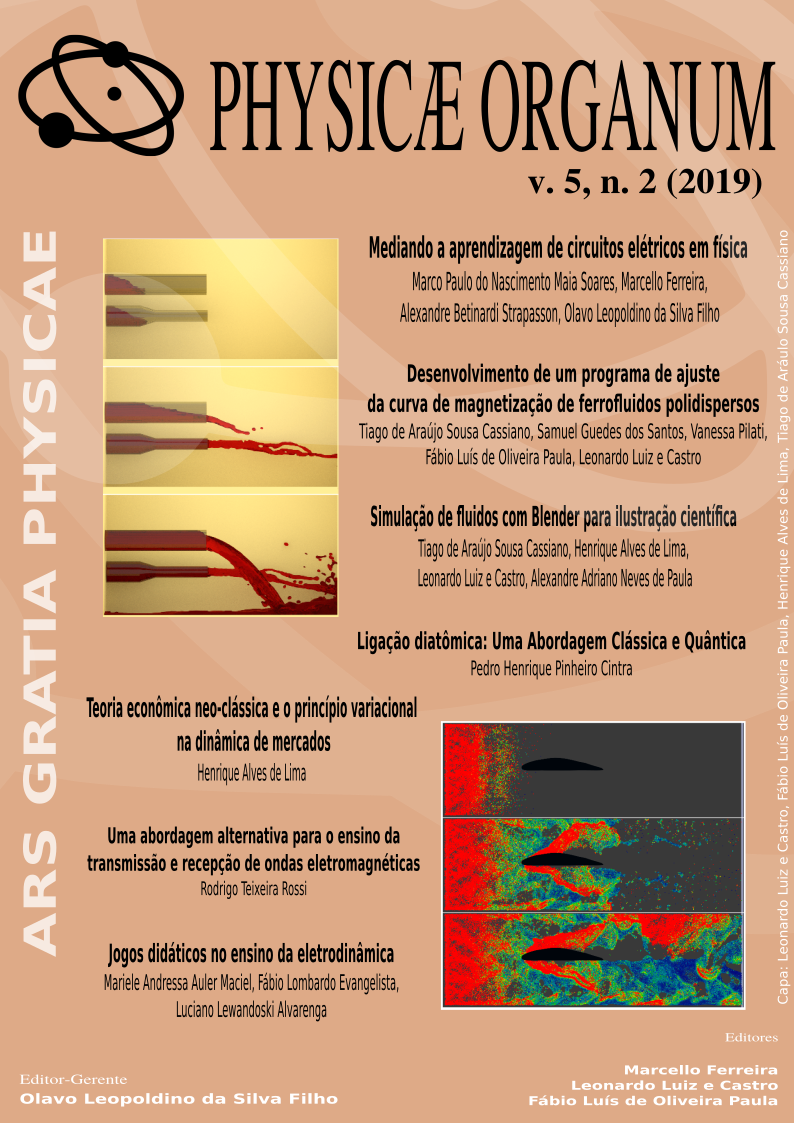Alternative approach to the teaching of electromagnetic waves transmission and reception
Abstract
Since Hertz, a new world of opportunity has emerged, where communication through electromagnetic waves has caused distances to become smaller and society has changed the way it communicates. Along with this innovation, technologies emerge all the time and acronyms like AM, FM, Wi-Fi and 4G have become commonplace in our lives, being widely used and little discussed in the classroom. The objective of this work is to bring an alternative approach on the transmission of electromagnetic waves, using representations of the modulation technique in a more pleasant and simple way, using analogies figures and animations that, used in the classroom, can increase and much the learning potential of students in a subject as current as this. Students who are very curious to learn this subject, but come up against and discourage theoretical and mathematical formalisms.
Downloads
References
ANJOS, V. R. D. Contextualização e o uso de simulações no ensino médio:, Rio de Janeiro, maio 2015.
AUSUBEL, D. P. The psychology of meaningful verbal learning. New York: [s.n.]. 1963.
BALANIS, C. A. Teoria de antenas. 3. ed. Rio de Janeiro: LTC, 2009.
BOYLESTAD, R.; NASHELSKY, L. Dispositivos eletrônicos e teoria de circuitos. 6. ed. Rio de Janeiro: LTC, 1999.
BRUSCATO, G. C.; MORS, P. M. Ensinando física através do radioamadorismo. Revista Brasileira de Ensino de Física, Porto Alegre, v. 36, n. 1, março 2014.
EFÃSICA. Noções elementares sobre ondas eletromagnéticas. efisica, 2007. Disponivel em: <http://efisica.if.usp.br/eletricidade/basico/ondas/ondas_eletromagneticas/>. Acesso em: 2 out. 2015.
FONTANA, E. Radiação e antenas, recife, 2013.
GLYNN, S. M. Teaching-with-analogies Model: Build. Science and children., 2007. 52-55.
LAMAR, M. V. Modulaçâo em amplitude, Universidade Federal do Paraná ”“Dep. de Engenharia Elétrica, 2005.
MEDEIROS, J. C. D. O. Princípios de telecomunicações. 2. ed. São Paulo: Érica, 2007.
MOREIRA, M. A. O que é afinal aprendizagem significativa?, Porto Alegre, 2012.
NUSSENZVEIG, H. M. Curso de física básica. São Paulo: Blucher, v. 3, 1997.
OTERO, M. R. £Cómo usar analogías en clases de física? Cad. Cat. Ens. Fís., v. 14, n. 2, p. p. 179-187, 1997.
PEREIRA, S. Modulação am e fm. Ebah, 2011. Disponivel em: <http://www.ebah.com.br/content/ABAAABqjUAI/modulacao-am-fm>. Acesso em: 2 maio 2015.
PIROPO, B. Modulação am e fm. IT FORUM 365, 2014. Disponivel em: <http://itforum365.com.br/blogs/post/113330/telefones-modulacao-am-efm>. Acesso em: 4 nov. 2015.
PORTAL EXPLICATORION. Heinrich Hertz. Portal Explicatórion, 2015. Acesso em: 1 maio 2015. Disponível em: http://www.explicatorium.com/biografias/Biografia_Heinrich_Hertz.php Acesso em: 26/01/2015.
RESNICK, H. Fundamentos da física. Rio deJaneiro: LTC, v. 4, 2009.
ROSSINI, R. T .transmissão e recepção de ondas eletromagnéticas: uma abordagem experimental para o ensino médio e técnico MNPEF UFRJ Rio de Janeiro , maio de 2016
TELECO. A. Ciclos Evolutivos: Grandes Descobertas, 2015. Disponivel em: <http://www.teleco.com.br/tutoriais/Acesso em: 17 abr. 2015.
WIKIPÉDIA. Tecnologia da informação. [S.l.]: [s.n.]. 2013. Disponível em: http://pt.wikipedia.org/wiki/Tecnologia_da_informação acesso em 26/01/2015.
WIKIPÉDIA. James Clerk Maxwell. 2016. Disponivel em: <https://pt.wikipedia.org/wiki/James_Clerk_Maxwell>. Acesso em: 02 jan. 2016.
Downloads
Published
How to Cite
Issue
Section
License
Autores que publicam nesta revista concordam com os seguintes termos:
Autores mantém os direitos autorais e concedem à revista o direito de primeira publicação, sendo o trabalho simultaneamente licenciado sob a Creative Commons Attribution License o que permite o compartilhamento do trabalho com reconhecimento da autoria do trabalho e publicação inicial nesta revista.
Autores têm autorização para assumir contratos adicionais separadamente, para distribuição não-exclusiva da versão do trabalho publicada nesta revista (ex.: publicar em repositório institucional ou como capítulo de livro), com reconhecimento de autoria e publicação inicial nesta revista.
Autores têm permissão e são estimulados a publicar e distribuir seu trabalho online (ex.: em repositórios institucionais ou na sua página pessoal) a qualquer ponto antes ou durante o processo editorial, já que isso pode gerar alterações produtivas, bem como aumentar o impacto e a citação do trabalho publicado (Veja O Efeito do Acesso Livre).




